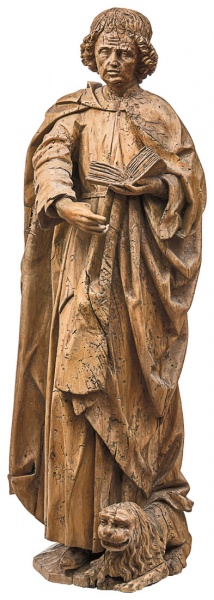
St Mark the Evangelist
| Author: |
Anton Pilgram ? (ca. 1460–1516)  |
| Created: | ca. 1508–1511 |
| Material: | wood |
| Technique: | carving |
| Dimensions: | 103 cm |
The Renaissance-style sculpture of St Mark has lost its original form: parts of it and some layers of primer and colour are missing, and only bits of blue and red paint can be seen in the folds of the clothes. According to its formal characteristics, the sculpture might be attributed to the German (possibly Prussian) school of sculpture of the late 15th and early 16th centuries. It was once a decorative part of a carved altar retabulum or a pulpit. It is easy to identify St Mark the Evangelist by his attributes: the book in his hands and the small lion curled up at his feet. The symbols of the four Evangelists, a lion, an angel, an ox and an eagle, that formed in the Christian tradition were based on the vision of the Prophet Ezekiel, who saw four winged creatures, each with four faces, a man, a lion, an ox and an eagle (Ez., 1, 4–14); and on the vaision described in the Apocalypse, in which four winged creatures, resembling a man, a lion, an ox and an eagle, appear as guardians of Our Lord’s Throne (Rev., 4, 6–8). Eventually, these mystical creatures were associated with the Evangelists, and their symbols became established in art. St Mark could have held a pen in his outstretched right hand, or maybe the now crumpled fingers concealed from sight one more feature identifying him, the cut-off thumb. The 13th-century Golden Legend by Jacobus de Voragine mentions that St Mark, who was famously humble, ‘out of his great humility’, cut off his thumb to make himself unfit for the priesthood.
Text author Dalia Vasiliūnienė
Source: Law firm Valiunas Ellex art album HEAVEN AND BEYOND (2016). Compiler Dalia Vasiliūnienė. Text authors Dalia Vasiliūnienė, Skaidrė UrbonienėExpositions: “Heaven and Beyond. Works of religious art from the collection of Rolandas Valiūnas and the law firm Valiunas Ellex“, 31 May–24 September 2016, Church Heritage Museum, Vilnius (curators Dalia Vasiliūnienė, Skaidrė Urbonienė)







